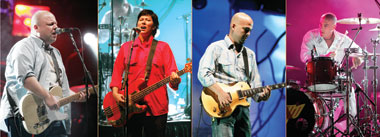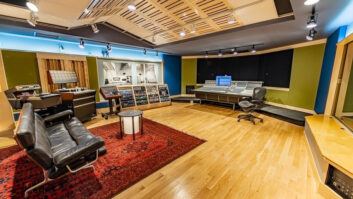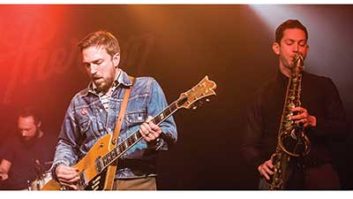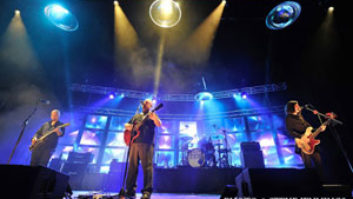
(Left to right) Guitarist/vocalist Black Francis, Bassist Kim Deal, Guitarist/vocalist Joey Santiago, Drummer David Lovering

In 1987, Ronald Reagan was president, the Soviet Union was still a communist world power and “pop” was the prevailing musical trend. But that was also the year that Boston-based The Pixies was formed. With their wildly eccentric lyrics, explosive guitar riffing and a solid back line, The Pixies helped usher in the alternative music movement that came to symbolize the most adventurous side of ’90s rock. (Nirvana, who would receive more credit for spreading alternative music, started around the same time in Seattle.)
But after making four studio albums, creating a huge fan base and earning an opening slot on U2’s 1992 Zoo TV tour, guitarist/vocalist Black Francis (aka Frank Black, real name Charles Thompson) announced the band’s breakup. Now, 12 years later, the band (bassist Kim Deal — who went on to play with The Breeders, another ’90s cult fave — drummer David Lovering, guitarist/vocalist Joey Santiago and Francis) reunited for a slew of sold-out tour dates — while many pop acts were canceling shows on their 2004 worldwide tours. Mix caught up with The Pixies and crew at Berkeley, Calif.’s Greek Theater at the end of September.
OLD FRIENDS KEEP IT SIMPLE
Front-of-house engineer Mathew Yelton is no stranger to Francis’ sound. He has been touring with the vocalist’s solo act for many years, as well as ensconced in Francis’ studio, working on the artist’s 1994 album, The Cult of Ray. Yelton is using a Midas Heritage 3000 at FOH, and is carrying everything but mains and amp racks for mains, which are provided by the venue or the promoter. “FOH will also have BSS EQ, which I barely use because I do it all in processing, whatever the house processing is, which is usually a SIA Smaart. Or the V-DOSC system in San Diego that Rat Sound has, we were using XTA,” Yelton explains.

Yelton puts Francis’ and Deal’s vocals through Summit tube compressors and has various catch-alls so that the show doesn’t sound too “polished” and processed. As for outboard gear, Yelton relies on Drawmer DS201 gates, Yamaha SPX-990s and SPX-3000 reverbs, TC Electronic D2s, dbx 160X compressors “for warmth” and Lexicon PCM70s. “When I talk to Charles [Black Francis] about the aesthetic, they have a particular sound,” Yelton says. “They’re not trying to emulate their albums because they have so many with such varying tones. I use no VCAs — I constantly have my fingers on the faders because there is so much bleed of hi-hat in the monitors that you can hear the reverb, so I’m constantly riding vocals, hats and snare reverb. I’m using lots of delay and reverb on the vocals as the quickest way to convey to the audience the sound of each particular album. It’s a pretty simple process and simple processing.”
While mixing during the show may be “simple,” tuning the many venues The Pixies are playing in takes a bit more careful thought. “I take the lead vocal mic and tweak the P.A.” Yelton says. “I take the oscillator on the Heritage and do rumble frequencies around the room.” With such a mixed bag of P.A.s — from the outdoor amphitheater’s V-DOSC, a newly installed JBL VerTec at the Greek in L.A., a Rat Sound system in San Diego, and various EAW and d&B models — Yelton is forced to work with whatever he has each day and contend with each venue’s SPL limits. “For this band, you need that dynamic range, so I use a little bit of stage sound — it’s just reinforcement,” Yelton says. “I just make them sound loud and clear — and turn it up as loud as you can go without hitting the [local SPL] limit!”
MONITOR WORLD, SAME AS THE FIRST
Just like Yelton, monitor engineer Ben Mumphrey has long been familiar with Francis’ sound — be it in the studio or onstage. As Mumphrey recalls, when The Pixies gig came up, he was “one of the guys” on Francis’ list.

L-R: front-of-house engineer Matthew Yelton, production manager/lighting designer/audio recording Myles Mangino, monitor engineer Ben Mumphrey and systems tech Kevin “Spike” Maloney.
At stage left, Mumphrey is also working on a Heritage 3000 with d&b M2 wedges, d&b C7 sidefills and amps; the band doesn’t rely on in-ears. “There are no effects at all, just inserts: gates on kick and snare and that’s it,” Mumphrey relates. “The mixes are sort of oddball; for instance, Kim doesn’t take any vocals at all in any of her wedges or the sidefills and really just hi-hat is cranked, which is painful. The drummer, David, almost takes nothing, just the slightest hint of bass and kick drum and he’ll occasionally ask for a vocal. Charles and Joe want nice, loud clear vocals. With the Midas board and d&b wedges, it’s certainly the best-sounding system that I’ve come across. It’s loud and clear, and if anything, they ask us to turn things down.” Mumphrey notes one unusual aspect on the position of the wedges: They’re behind the band rather than in front. “Charles just thinks that it makes for a cleaner stage. I think he told me that he saw Danzig do it once and said, ‘Hey, I want to do that.’”
Par for the tour, Mumphrey’s mixing techniques are straightforward and clean: “I just ride the snares during fast songs. With the system we have now, it pretty much stays the same every night. With Black’s vocal, you’re trying to get it loud enough to not feed back, but right in his ear. He doesn’t wear earplugs, so you get it loud enough so that he can feel it.”
With minimal outboard gear — save Drawmer DS201B gates — no keyboards, no sampling and no instrument-switching, Mumphrey finds mixing for The Pixies a breeze: “They don’t even move the microphones at all — they hardly move onstage at all as a band.”
FROM DISCLIVE TO MUSICTODAY
While The Pixies are rocking out onstage — albeit at a visual standstill — production manager/lighting designer Myles Mangino is recording each show to upload to Internet music site MusicToday.com. During the spring tour, The Pixies employed DiscLive (see “On-the-Spot CD Release,” May 2004 Mix for more info on DiscLive) to record each night’s show, burn the audio files to CD
and sell to eagerly waiting fans 15 minutes after the show closes.
According to Mangino, DiscLive has been sold to an unnamed company and no longer exists; sources at DiscLive could not be reached for comment.
“Unfortunately,” Mangino says, “[DiscLive] had a great thing going on: They were selling lots of CDs at the end of the show, they had a great package — everything about it was excellent. Even after all of the shows that we’ve done since, I’ve probably had 50 people come up to me asking, ‘Where are the CDs?’ They can’t even believe they’re not for sale. They think I’m not telling the truth.

“Even before the tour started and being a Pro Tools engineer,” he continues, “I really wanted to have a portable rig to play with demos, and when The [Pixies’] management asked me to start recording the show, they said, ‘Oh, you already have a rig.’ I walk out to the [FOH] board, set it up during the opening acts and it only takes 10 minutes. The whole rig fits into a laptop briefcase.”
During the show, Mangino records to Digidesign Mbox on his PowerBook into Pro Tools. Audio is provided by 2-track board mixes, which go straight into the Mbox. Mumphrey then takes the tracks to edit and EQ. “To me, it’s a more realistic sound — it sounds like you’re at the show. It’s more live, you don’t have to worry about strange levels happening as the engineer is moving faders. So far, everyone’s liked the way it sounds.” Post-show, Mangino does a bit of mastering to the one audio file (although he does employ FireWire for backup), divides the files, puts phase in the beginning and end of each track, converts down to MP3 and uploads it to the site, where fans can download the whole show as one package.
While recording only one file may seem a bit risky, Mangino relies on his history with the band (he was with them in their original years, too) and as a producer/recording engineer to capture each nuance. “ I’ve been a record producer/recording engineer for the past 10 years,”; he relates,
“so I kind of came out of retirement from the studio to do this tour. They really wanted me back as one of their original people and they are a very loyal band. So it was kind of bringing back the show that they had 13 years ago.”

Sarah Benzuly is Mix‘s senior associate editor.
Mic List
Drums: Shure 91 in the kick, SM81 (overheads), Beta 57 (snares); Beta 52 outside the kick, under the floor tom; MXL 603 for hi-hat to pick up the sticks: “It’s kind of like the Neumann KLM 127: They sound old-school,” says Yelton; Sennheiser E604 for toms
Guitars: Beta 57, Sennheiser Evolution 609 on each cabinet
Bass: Sennheiser 421
Vocals: Shure Beta 58s





